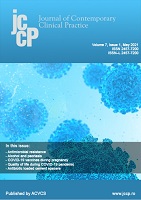Antimicrobial activity of antibiotic loaded cement spacers
Antimicrobial activity of antibiotic loaded cement spacers
Author(s): Mihai ColțanSubject(s): Health and medicine and law
Published by: Asociația pentru Creșterea Vizibilității Cercetării Științifice (ACVCS)
Keywords: Prosthetic joint infection; cement spacer; antibiotic cement;
Summary/Abstract: The two-stage revision technique is the most frequently used method for the treatment of prosthetic joint infection (PJI). It needs the use of a temporary bone cement spacer loaded with different types of antibiotics. Gentamicin and vancomycin are often used in cement spacers, alone or in association with other antibiotics, but there is no consensus on the concentrations and the period of time that they should be used. Therefore, the purpose of this study was to compare the antibiotic elution in time between gentamicin and vancomycin, to see for how long the cement retains antimicrobial activity. We used two types of antibiotic-loaded acrylic cement (polymethyl methacrylate – PMMA). One was prefabricated, containing 40 g of cement powder and 2 g of gentamicin. The second one was handmade containing 40 g cement powder and 2 g of vancomycin. Every day, we took two cement tablets, one with vancomycin and one with gentamicin and transferred them to a Mueller Hinton E (MHE) culture environment previously inoculated with 0.05 McFarland Staphylococcus aureus reference strain ATCC 25923. The dish was incubated at 37°C for 24 hours, after which the sample was read, measuring the inhibition area around the cement tablet. We read the results daily, by measuring the inhibition area around the cement. For both types of cement the maximum inhibition area was recorded in the first day and it measured 16/17 mm in the vancomycin cement and 34/40 mm in the gentamicin cement. Both antibiotics had good minimal inhibition concentration (MIC) in the first 6 weeks of the study. We obtained inhibition areas exceeding 10 mm around the cement in the first 45 days. In the 60th day, the inhibition area around the gentamicin cement started to decrease progressively under 10 mm and on the 64th day it disappeared completely. Regarding the vancomycin cement, the inhibition area started to decrease from the 66th day, until becoming completely absent on the 68th day. For both types of antibiotic cement, we obtained a bactericidal effect (an area of inhibition) in first 8 weeks of the study. Maintaining a spacer in place for more than 8 weeks could bring no benefit. On the contrary it might allow bacteria to adhere and form a biofilm, making the antibiotherapy useless after 8 weeks, if the pathogenic agent is still present.
Journal: Journal of Contemporary Clinical Practice
- Issue Year: 7/2021
- Issue No: 1
- Page Range: 31-34
- Page Count: 4
- Language: English

